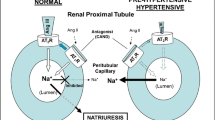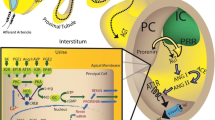Abstract
The kidney contains a renin-angiotensin system that appears to regulate systemic blood pressure. Angiotensin II (Ang II) has stimulatory effects on sodium transport in multiple nephron segments via binding to plasma membrane AT1 receptors. In the proximal tubule, Ang II production is substantial. The stimulatory effect of Ang II on proximal sodium transport is enhanced by renal nerves, and is associated with internalization of apical and basolateral receptors. In the cortical collecting duct, AT1 receptors stimulate transport through apical sodium channels, and in the inner medulla, urea transport is enhanced by Ang II, contributing to increased sodium and water reabsorption. AT1 receptors may also be linked to increased expression of certain tubular sodium transporters. In contrast to the stimulatory effects of AT1 receptors on sodium transport, AT2 receptors expressed in the adult kidney are linked to increased urinary sodium excretion and decreased blood pressure. This suggests that renal tubular AT1 receptor activation serves as a protective mechanism to increase sodium reabsorption and blood pressure when extracellular fluid volume is threatened, whereas AT2 receptors dampen this response. The interplay between these two receptor pathways in the kidney could have significant effects on long-term blood pressure control.
Similar content being viewed by others
References and Recommended Reading
Braam B, Mitchell KD, Fox J, et al.: Proximal tubular secretion of angiotensin II in rats. Am J Physiol 1993, 264:F891-F898.
Seikaly MG, Arant BS Jr, Seney FD Jr: Endogenous angiotensin concentrations in specific intrarenal fluid compartments of the rat. J Clin Invest 1990, 86:1352–1357.
Nishiyama A, Seth DM, Navar LG: Renal interstitial fluid concentrations of angiotensins I and II in anesthetized rats. Hypertension 2002, 39:129–134.
Felder RA, Seikaly MG, Cody P, et al.: Immunohistochemical localization of Ang II AT1 receptor in adult rat kidney using a monoclonal antibody. Am J Physiol 1997, 273(1 Pt 2): F170-F177.
Ozono R, Wang ZQ, Moore AF, et al.: Expression of the subtype 2 angiotensin (AT2) receptor protein in rat kidney. Hypertension 1997, 30:1238–1246.
Kennedy CR, Burns KD: Angiotensin II as a mediator of renal tubular transport. Contrib Nephrol 2001, 47–62.
Oliverio MI, Best CF, Smithies O, et al.: Regulation of sodium balance and blood pressure by the AT(1A) receptor for angiotensin II. Hypertension 2000, 35:550–554.
Mangrum AJ, Gomez RA, Norwood VF: Effects of AT (1A) receptor deletion on blood pressure and sodium excretion during altered dietary salt intake. Am J Physiol Renal Physiol 2002, 283:F447-F453.
Ding Y, Davisson RL, Hardy DO, et al.: The kidney androgenregulated protein promoter confers renal proximal tubule cell-specific and highly androgen-responsive expression on the human angiotensinogen gene in transgenic mice. J Biol Chem 1997, 272:28142–28148.
Davisson RL, Ding Y, Stec DE, et al.: Novel mechanism of hypertension revealed by cell-specific targeting of human angiotensinogen in transgenic mice. Physiol Genomics 1999, 1:3–9. This study in transgenic mice shows that selective activation of the RAS within the kidney causes hypertension, independent of the systemic RAS, demonstrating the important role of intrarenal Ang II in blood pressure regulation.
Nishiyama A, Seth DM, Navar LG: Renal interstitial fluid angiotensin I and angiotensin II concentrations during local angiotensin-converting enzyme inhibition. J Am Soc Nephrol 2002, 13:2207–2212.
Quan A, Baum M: Endogenous production of angiotensin II modulates rat proximal tubule transport. J Clin Invest 1996, 97:2878–2882.
Quan A, Baum M: Endogenous angiotensin II modulates rat proximal tubule transport with acute changes in extracellular volume. Am J Physiol 1998, 275(1 Pt 2):F74-F78.
Quan A, Baum M: The renal nerve is required for regulation of proximal tubule transport by intraluminally produced Ang II. Am J Physiol Renal Physiol 2001, 280:F524-F529.
Quan A, Baum M: Renal nerve stimulation augments effect of intraluminal angiotensin II on proximal tubule transport. Am J Physiol Renal Physiol 2002, 282:F1043-F1048. Renal sympathetic nerves augment the stimulatory effect of luminal Ang II on proximal tubule transport, suggesting that Ang II production or action may be enhanced with nerve stimulation.
Thekkumkara T, Linas SL: Role of internalization in AT(1A) receptor function in proximal tubule epithelium. Am J Physiol Renal Physiol 2002, 282:F623-F629. Apical AT1 receptors in the proximal tubule internalize before interacting with G proteins, whereas basolateral AT1 receptors can activate G proteins without internalization, which appears to represent a unique pathway for Ang II to stimulate sodium transport in polarized epithelial cells.
Green DM, Ropper AH, Kronmal RA, et al.: Serum potassium level and dietary potassium intake as risk factors for stroke. Neurology 2002, 59:314–320.
Burns KD, Smith IB: Potassium depletion stimulates mRNA expression of proximal tubule AT1 angiotensin II receptors. Nephron 1998, 78:73–81.
Fryer JN, Burns KD, Ghorbani M, Levine DZ: Effect of potassium depletion on proximal tubule AT1 receptor localization in normal and remnant rat kidney. Kidney Int 2001, 60:1792–1799.
Robey RB, Ruiz OS, Espiritu DJ, et al.: Angiotensin II stimulation of renal epithelial cell na/hco3 cotransport activity: a central role for src family kinase/classic mapk pathway coupling. J Membr Biol 2002, 187:135–145.
Espiritu DJ, Bernardo AA, Robey RB, et al.: A central role for Pyk2-Src interaction in coupling diverse stimuli to increased epithelial NBC activity. Am J Physiol Renal Physiol 2002, 283:F663-F670.
Kovacs G, Peti-Peterdi J, Rosivall L, et al.: Angiotensin II directly stimulates macula densa Na-2Cl-K cotransport via apical AT (1) receptors. Am J Physiol Renal Physiol 2002, 282:F301-F306.
Peti-Peterdi J, Warnock DG, Bell PD: Angiotensin II directly stimulates ENaC activity in the cortical collecting duct via AT(1) receptors. J Am Soc Nephrol 2002, 13:1131–1135. This is the first direct evidence demonstrating that Ang II stimulates sodium transport in the collecting duct via apical membrane sodium channels. This suggests that Ang II plays an important role in the fine-tune regulation of sodium excretion by the kidney, and thereby also adjusts extracellular fluid volume.
Rohrwasser A, Morgan T, Dillon HF, et al.: Elements of a paracrine tubular renin-angiotensin system along the entire nephron. Hypertension 1999, 34:1265–1274.
Oliverio MI, Delnomdedieu M, Best CF: Abnormal water metabolism in mice lacking the type 1A receptor for Ang II. Am J Physiol Renal Physiol 2000, 278:F75-F82.
Kato A, Klein JD, Zhang C, Sands JM: Angiotensin II increases vasopressin-stimulated facilitated urea permeability in rat terminal IMCDs. Am J Physiol Renal Physiol 2000, 279:F835-F840.
Brooks HL, Allred AJ, Beutler KT, et al.: Targeted proteomic profiling of renal Na(+) transporter and channel abundances in angiotensin II type 1a receptor knockout mice. Hypertension 2002, 39:470–473. This study shows for the first time that AT1 receptors stimulate protein expression of certain renal tubular transporters, indicating a novel mechanism by which Ang II might modulate long-term blood pressure.
Carey RM, Jin XH, Siragy HM: Role of the angiotensin AT2 receptor in blood pressure regulation and therapeutic implications. Am J Hypertens 2001, 14:98S-102S.
Oliverio MI, Kim HS, Ito M, et al.: Reduced growth, abnormal kidney structure, and type 2 (AT2) angiotensin receptormediated blood pressure regulation in mice lacking both AT1A and AT1B receptors for angiotensin II. Proc Natl Acad Sci U S A 1998, 95:15496–15501.
Carey RM, Howell NL, Jin XH, et al.: Angiotensin type 2 receptor-mediated hypotension in angiotensin type-1 receptor-blocked rats. Hypertension 2001, 38:1272–1277.
Siragy HM, Inagami T, Ichiki T, Carey RM: Sustained hypersensitivity to angiotensin II and its mechanism in mice lacking the subtype-2 (AT2) angiotensin receptor. Proc Natl Acad Sci U S A 1999, 96:6506–6510.
Gross V, Schunck WH, Honeck H, et al.: Inhibition of pressure natriuresis in mice lacking the AT2 receptor. Kidney Int 2000, 57:191–202.
Wehbi GJ, Zimpelmann J, Carey RM, et al.: Early streptozotocin-diabetes mellitus downregulates rat kidney AT2 receptors. Am J Physiol Renal Physiol 2001, 280:F254-F265.
Moore AF, Heiderstadt NT, Huang E, et al.: Selective inhibition of the renal angiotensin type 2 receptor increases blood pressure in conscious rats. Hypertension 2001, 37:1285–1291. Using intrarenal infusion of antisense oligonucleotides to the AT2 receptor in rats, the authors show that blood pressure increases and urine sodium excretion is impaired. This important study therefore indicates that intrarenal AT2 receptors mediate hypotensive effects, perhaps by directly inhibiting tubular sodium transport.
Siragy HM, Carey RM: The subtype 2 (AT2) angiotensin receptor mediates renal production of nitric oxide in conscious rats. J Clin Invest 1997, 100:264–269.
Siragy HM, El-Kersh MA, De Gasparo M, et al.: Differences in AT2 -receptor stimulation between AT1 -receptor blockers valsartan and losartan quantified by renal interstitial fluid cGMP. J Hypertens 2002, 20:1157–1163.
Jin XH, Siragy HM, Carey RM: Renal interstitial cGMP mediates natriuresis by direct tubule mechanism. Hypertension 2001, 38:309–316.
Author information
Authors and Affiliations
Rights and permissions
About this article
Cite this article
Burns, K.D., Li, N. The role of angiotensin II-stimulated renal tubular transport in hypertension. Current Science Inc 5, 165–171 (2003). https://doi.org/10.1007/s11906-003-0074-1
Issue Date:
DOI: https://doi.org/10.1007/s11906-003-0074-1




